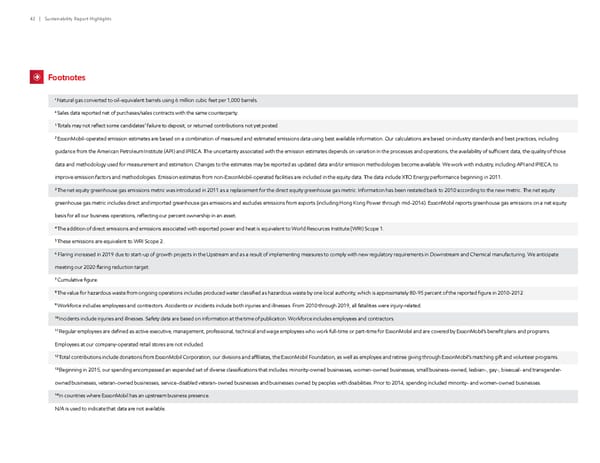Footnotes † Natural gas converted to oil-equivalent barrels using 6 million cubic feet per 1,000 barrels. ‡ Sales data reported net of purchases/sales contracts with the same counterparty. 1 Totals may not reflect some candidates’ failure to deposit, or returned contributions not yet posted. 2 ExxonMobil-operated emission estimates are based on a combination of measured and estimated emissions data using best available information. Our calculations are based on industry standards and best practices, including guidance from the American Petroleum Institute (API) and IPIECA. The uncertainty associated with the emission estimates depends on variation in the processes and operations, the availability of sufficient data, the quality of those data and methodology used for measurement and estimation. Changes to the estimates may be reported as updated data and/or emission methodologies become available. We work with industry, including API and IPIECA, to improve emission factors and methodologies. Emission estimates from non-ExxonMobil-operated facilities are included in the equity data. The data include XTO Energy performance beginning in 2011. 3 The net equity greenhouse gas emissions metric was introduced in 2011 as a replacement for the direct equity greenhouse gas metric. Information has been restated back to 2010 according to the new metric. The net equity greenhouse gas metric includes direct and imported greenhouse gas emissions and excludes emissions from exports (including Hong Kong Power through mid-2014). ExxonMobil reports greenhouse gas emissions on a net equity basis for all our business operations, reflecting our percent ownership in an asset. 4 The addition of direct emissions and emissions associated with exported power and heat is equivalent to World Resources Institute (WRI) Scope 1. 5 These emissions are equivalent to WRI Scope 2. 6 Flaring increased in 2019 due to start-up of growth projects in the Upstream and as a result of implementing measures to comply with new regulatory requirements in Downstream and Chemical manufacturing. We anticipate meeting our 2020 flaring reduction target. 7 Cumulative figure. 8 The value for hazardous waste from ongoing operations includes produced water classified as hazardous waste by one local authority, which is approximately 80-95 percent of the reported figure in 2010-2012. 9 Workforce includes employees and contractors. Accidents or incidents include both injuries and illnesses. From 2010 through 2019, all fatalities were injury-related. 10 Incidents include injuries and illnesses. Safety data are based on information at the time of publication. Workforce includes employees and contractors. 11 Regular employees are defined as active executive, management, professional, technical and wage employees who work full-time or part-time for ExxonMobil and are covered by ExxonMobil’s benefit plans and programs. Employees at our company-operated retail stores are not included. 12 Total contributions include donations from ExxonMobil Corporation, our divisions and affiliates, the ExxonMobil Foundation, as well as employee and retiree giving through ExxonMobil’s matching gift and volunteer programs. 13 Beginning in 2015, our spending encompassed an expanded set of diverse classifications that includes: minority-owned businesses, women-owned businesses, small business-owned, lesbian-, gay-, bisexual- and transgender- owned businesses, veteran-owned businesses, service-disabled veteran-owned businesses and businesses owned by peoples with disabilities. Prior to 2014, spending included minority- and women-owned businesses. 14 In countries where ExxonMobil has an upstream business presence. N/A is used to indicate that data are not available. 42 | Sustainability Report Highlights
 ExxonMobil ESG Report Page 41 Page 43
ExxonMobil ESG Report Page 41 Page 43